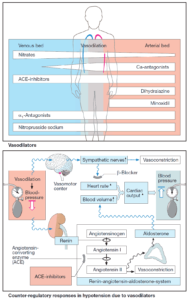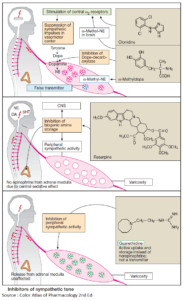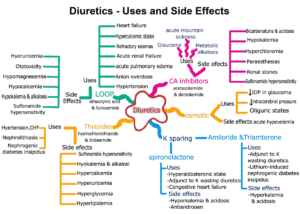Deoxyribonucleic acid (DNA) serves as a template for the synthesis of nucleic acids. Ribonucleic acid (RNA) executes protein synthesis and thus permits cell growth. Synthesis of new DNA is a prerequisite for cell division.
Substances that inhibit reading of genetic information at the DNA template damage the regulatory center of cell metabolism. The substances listed below are useful as antibacterial drugs because they do not affect human cells.
Gyrase inhibitors
The enzyme gyrase (topoisomerase II) permits the orderly accommodation of a ~1000 μmlong bacterial chromosome in a bacterial cell of ~1 μm. Within the chromosomal strand, double-stranded DNA has a double helical configuration.
The former, in turn, is arranged in loops that are shortened by supercoiling. The gyrase catalyzes this operation, as illustrated, by opening, underwinding, and closing the DNA double strand such that the full loop need not be rotated.
Derivatives of 4-quinolone-3-carboxylic acid (green portion of ofloxacin formula) are inhibitors of bacterial gyrases. They appear to prevent specifically the resealing of opened strands and thereby act bactericidally. These agents are absorbed after oral ingestion.
The older drug, nalidixic acid, affects exclusively gram-negative bacteria and attains effective concentrations only in urine; it is used as a urinary tract antiseptic.
Norfloxacin has a broader spectrum. Ofloxacin, ciprofloxacin, and enoxacin, and others, also yield systemically effective concentrations and are used for infections of internal organs.
Besides gastrointestinal problems and allergy, adverse effects particularly involve the CNS (confusion, hallucinations, seizures). Since they can damage epiphyseal chondrocytes and joint cartilages in laboratory animals, gyrase inhibitors should not be used during pregnancy, lactation, and periods of growth.
Azomycin (nitroimidazole) Derivatives – Metronidazole
Azomycin (nitroimidazole) derivatives, such as metronidazole, damage DNA by complex formation or strand breakage. This occurs in obligate anaerobes, i.e., bacteria growing under O2 exclusion. Under these conditions, conversion to reactive metabolites that attack DNA takes place (e.g., the hydroxylamine shown). The effect is bactericidal.
A similar mechanism is involved in the antiprotozoal action on Trichomonas vaginalis (causative agent of vaginitis and urethritis) and Entamoeba histolytica (causative agent of large bowel inflammation, amebic dysentery, and hepatic abscesses).
Metronidazole is well absorbed via the enteral route; it is also given i.v. or topically (vaginal insert). Because metronidazole is considered potentially mutagenic, carcinogenic, and teratogenic in the human, it should not be used longer than 10 d, if possible, and be avoided during pregnancy and lactation. Timidazole may be considered equivalent to metronidazole.
Rifampin
Rifampin inhibits the bacterial enzyme that catalyzes DNA template-directed RNA transcription, i.e., DNA-dependent RNA polymerase. Rifampin acts bactericidally against mycobacteria (M. tuberculosis, M. leprae), as well as many gram-positive and gram-negative bacteria.
It is well absorbed after oral ingestion. Because resistance may develop with frequent usage, it is restricted to the treatment of tuberculosis and leprosy. Rifampin is contraindicated in the first trimester of gestation and during lactation.
Rifabutin resembles rifampin but may be effective in infections resistant to the latter.
Read Also : Appropriate Antibiotics for Resistant Organisms




